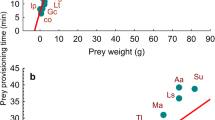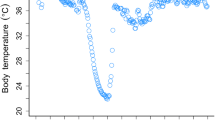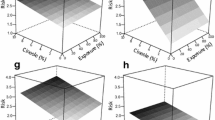Abstract
Recent theoretical models have considered how nutritional status and predation risk affect the decision by an individual to forage. We consider the feeding behaviour of a scavenger under risk of predation. The intertidal gastropod Nassarius dorsatus Röding was used to test the following hypotheses: (1) a damaged conspecific should be a less preferred meal than a damaged predator or another species; (2) a scavenger should be able to discriminate between a damaged conspecific in the presence and one in the absence of its predator, preferring the latter; and (3) the decision by a scavenger to feed should reflect a trade-off between nutritional status and the above preferences. Results from the laboratory and field were consistent with predictions. Two hypotheses are suggested from the work: scavengers may generally be less willing to feed on carcases of conspecifics than on those of other species, and intertidal scavengers may commonly face a relative or absolute shortage of food.
Similar content being viewed by others
References
Alexander JE Jr, Covich AP (1991) Predator avoidance by the freshwater snail Physella virgata in response to the crayfish Procambarus simulans. Oecologia 87:435–442
Cernohorsky WO (1978) Tropical Pacific marine shells. Pacific publications, Sydney
Cerri RD, Fraser DF (1983) Predation and risk in foraging minnows: balancing conflicting demands. Am Nat 121:552–561
Crisp M (1978) Effects of feeding on the behaviour of Nassarius species (Gastropoda: Prosobranchia). J Mar Biol Ass UK 58:659–669
Hill BJ (1976) Natural food, foregut clearance-rate and activity of the crab Scylla serrata. Mar Biol 34:109–116
Holbrook SJ, Schmitt RJ (1988) The combined effects of predation risk and food reward on patch selection. Ecology 69:125–134
Lima SL (1985) Maximizing feeding efficiency and minimizing time exposed to predators: a trade-off in the black-capped chickadee. Oecologia 66:60–67
Lima SL, Dill LM (1990) Behavioral decisions made under the risk of predation: a review and prospectus. Can J Zool 68:619–640
MacArthur RH, Pianka ER (1966) On optimal use of a patchy environment. Am Nat 100:603–609
McKillup SC (1983) A behavioural polymorphism in the marine snail Nassarius pauperatus: geographic variation correlated with resource availability and differences in competitive ability between morphs. Oecologia 56:58–66
McKillup SC, Butler AJ (1979) Modification of egg production and packaging in response to food availability by Nassarius pauperatus. Oecologia 43:221–231
McKillup SC, Butler AJ (1983) The measurement of hunger as a relative estimate of food available to populations of Nassarius pauperatus. Oecologia 56:16–22
McKillup SC, McKillup RV (1992) Inhibition of feeding in response to crushed conspecifics by the pebble crab Philyra laevis (Bell). J Exp Mar Biol Ecol 161:33–43
McKillup SC, McKillup RV (1993) Behavior of the intertidal gastropod Planaxis sulcatus (Born 1780) in Fiji: are responses to damaged conspecifics and predators more pronounced on tropical versus temperate shores? Pac Sci 47:401–407
McNamara JM (1990a) The policy which maximises long-term survival of an animal faced with the risks of starvation and predation. Adv Appl Prob 22:295–308
McNamara JM (1990b) The starvation-predation trade-off and some behavioural and ecological consequences. In: Hughes RN (ed) Behavioural mechanisms of food selection (NATO ASI Series G20). Springer-Verlag, Berlin, pp 39–59
McNamara JM, Houston AI (1990) The value of fat reserves and the tradeoff between starvation and predation. Acta Biotheor 38:37–61
Milinski M, Heller R (1978) Influence of a predator on the optimal foraging behaviour of sticklebacks (Gasterosteus aculeatus L.). Nature 275:642–644
Richardson TD, Brown KM (1992) Predation risk and feeding in an intertidal predatory snail. J Exp Mar Biol Ecol 163:169–182
Ricklefs RE (1990) Ecology, 3rd edn. Freeman, New York
Short JW, Potter DG (1987) Shells of Queensland and the Great Barrier Reef. Robert Brown and Associates, Bathurst NSW
Sih A (1980) Optimal behavior: Can foragers balance two conflicting demands? Science 210:1041–1043
Sih A (1982) Foraging strategies and the avoidance of predation by an aquatic insect, Notonecta hoffmanni. Ecology 63:786–796
Sih A (1988) The effects of predators on habitat use, activity and mating behaviour of a semi-aquatic bug. Anim Behav 36:1846–1848
Soluk DA, Collins NC (1988) Balancing risks? Responses and non-responses of mayfly larvae to fish and stonefly predators. Oecologia 77:370–374
Stein RA, Magnuson JJ (1976) Behavioral response of crayfish to a fish predator. Ecology 57:751–761
Stenton-Dozey JME, Brown AC (1988) Feeding, assimilation and scope for growth in the scavenging sandy beach neogastropod Bullia digitalis (Dillwyn). J Exp Mar Biol Ecol 119:253–268
Vermeij GJ (1978) Biogeography and adaptation: patterns of marine life. Harvard University Press, Cambridge
White TCR (1978) The importance of a relative shortage of food in animal ecology. Oecologia 33:71–86
Zar JH (1984) Biostatistical analysis, 2nd edn. Prentice-Hall, New York
Zipser E, Vermeij GJ (1978) Crushing behaviour of tropical and temperate crabs. J Exp Mar Biol Ecol 31:155–172
Author information
Authors and Affiliations
Rights and permissions
About this article
Cite this article
McKillup, S.C., McKillup, R.V. The decision to feed by a scavenger in relation to the risks of predation and starvation. Oecologia 97, 41–48 (1994). https://doi.org/10.1007/BF00317907
Issue Date:
DOI: https://doi.org/10.1007/BF00317907




